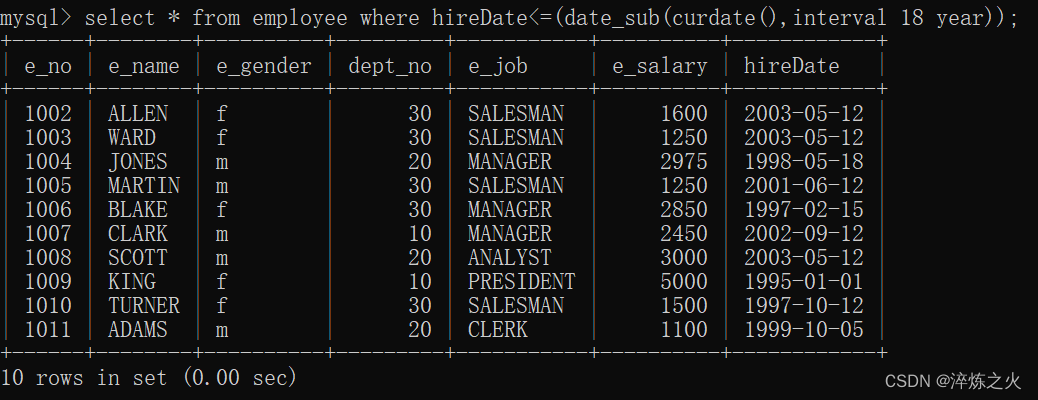MYSQL:查询数据

一、学习目标
- 了解基本查询语句
- 掌握表单查询的方法
- 掌握如何使用几何函数的查询
- 掌握连接查询的方法
- 掌握如何使用子查询
- 熟悉合并查询结果
- 熟悉如何为表和字段取别名
- 掌握如何使用正则表达式查询
- 掌握数据表的查询操作技巧和方法
二、实验内容
根据不同条件对表进行查询操作,掌握数据表的查询语句。Employee、dept表结构以及表中的记录如下表所示
employee表结构
|
字段名 |
字段说明 |
数据类型 |
主键 |
外键 |
非空 |
唯一 |
自增 |
|
e_no |
员工编号 |
INT(11) |
是 |
否 |
是 |
是 |
否 |
|
e_name |
员工姓名 |
VARCHAR(50) |
否 |
否 |
是 |
否 |
否 |
|
e_gender |
员工性别 |
CHAR(2) |
否 |
否 |
否 |
否 |
否 |
|
dept_no |
部门编号 |
INT(11) |
否 |
否 |
是 |
否 |
否 |
|
e_job |
职位 |
VARCHAR(50) |
否 |
否 |
是 |
否 |
否 |
|
e_salary |
薪水 |
INT(11) |
否 |
否 |
是 |
否 |
否 |
|
hireDate |
入职日期 |
DATE |
否 |
否 |
是 |
否 |
否 |
dept表结构
|
字段名 |
字段说明 |
数据类型 |
主键 |
外键 |
非空 |
唯一 |
自增 |
|
d_no |
部门编号 |
INT(11) |
是 |
是 |
是 |
是 |
否 |
|
d_name |
部门名称 |
VARCHAR(50) |
否 |
否 |
是 |
否 |
否 |
|
d_location |
部门地址 |
VARCHAR(100) |
否 |
否 |
否 |
否 |
否 |
employee表中的记录
|
e_no |
e_name |
e_gender |
dept_no |
e_job |
e_salary |
hireDate |
|
1001 |
SMITH |
m |
20 |
CLERK |
800 |
2005-11-12 |
|
1002 |
ALLEN |
f |
30 |
SALESMAN |
1600 |
2003-05-12 |
|
1003 |
WARD |
f |
30 |
SALESMAN |
1250 |
2003-05-12 |
|
1004 |
JONES |
m |
20 |
MANAGER |
2975 |
1998-05-18 |
|
1005 |
MARTIN |
m |
30 |
SALESMAN |
1250 |
2001-06-12 |
|
1006 |
BLAKE |
f |
30 |
MANAGER |
2850 |
1997-02-15 |
|
1007 |
CLARK |
m |
10 |
MANAGER |
2450 |
2002-09-12 |
|
1008 |
SCOTT |
m |
20 |
ANALYST |
3000 |
2003-05-12 |
|
1009 |
KING |
f |
10 |
PRESIDENT |
5000 |
1995-01-01 |
|
1010 |
TURNER |
f |
30 |
SALESMAN |
1500 |
1997-10-12 |
|
1011 |
ADAMS |
m |
20 |
CLERK |
1100 |
1999-10-05 |
|
1012 |
JAMES |
f |
30 |
CLERK |
950 |
2008-06-15 |
dept表中的记录
|
d_no |
d_name |
d_location |
|
10 |
ACCOUNTING |
ShangHai |
|
20 |
RESEARCH |
BeiJing |
|
30 |
SALES |
ShenZhen |
|
40 |
OPERATIONS |
FuJian |
步骤如下:
①创建数据表employee和dept
②将指定记录分别插入两个表中
③在employee表中,查询所有记录的e_no、e_name和e_salary字段值
④在employee表中,查询dept_no等于10和20的所有记录
⑤在employee表中,查询工资范围在800~2500之间的员工信息
⑥在employee表中,查询部门编号为20的部门中的员工信息
⑦在employee表中,查询每个部门最高工资的员工信息
⑧查询员工BLAKE所在部门和部门所在地
⑨使用连接查询,查询所有员工的部门和部门信息
⑩在employee表中,计算每个部门各有多少名员工
⑪在employee表中,计算不同类型职工的总工资数
⑫在employee表中,计算不同部门的平均工资
⑬在employee表中,查询工资低于1500的员工信息
⑭在employee表中,将查询记录先按部门编号由高到低排列,再按员工工资从高到低排列
⑮在employee表中,查询员工姓名以字母‘A’或‘S’开头的员工的信息
⑯在employee表中,查询到目前为止工龄大于等于18年的员工信息
1.
create table dept(d_no int(11) not null primary key unique ,d_name varchar(50) not null,d_location varchar(100));create index d_no on employee(dept_no);
/*索引,没索引给不了外键*/create table employee(e_no int(11) primary key not null unique,e_name varchar(50) not null,e_gender char(2),dept_no int(11) not null,e_job varchar(50) not null,e_salary int(11) not null,hireDate date not null ,foreign key(dept_no) references dept(d_no));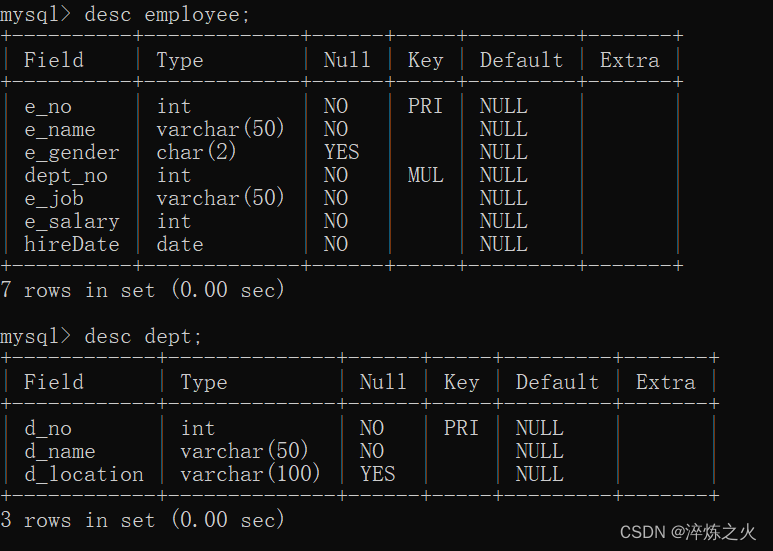
2.
insert into dept(d_no,d_name,d_location)values(10,'ACCOUNTING','ShangHai'),
(20,'RESEARCH','BeiJing'),
(30,'SALES','ShenZhen'),
(40,'OPERATIONS','FuJian');insert into employee(e_no,e_name,e_gender,dept_no,e_job,e_salary,hireDate)values(1001,'SMITH','m',20,'CLERK',800,'2005-11-12'),(1002, 'ALLEN', 'f', 30, 'SALESMAN', 1600, '2003-05-12'),(1003,'WARD','f',30,'SALESMAN',1250,'2003-05-12'),(1004,'JONES','m',20,'MANAGER',2975,'1998-05-18'),(1005,'MARTIN','m',30,'SALESMAN',1250,'2001-06-12'),(1006,'BLAKE','f',30,'MANAGER',2850,'1997-02-15'),(1007,'CLARK','m',10,'MANAGER',2450,'2002-09-12'),(1008,'SCOTT','m',20,'ANALYST',3000,'2003-05-12'),(1009,'KING','f',10,'PRESIDENT',5000,'1995-01-01'),(1010,'TURNER','f',30,'SALESMAN',1500,'1997-10-12'),(1011,'ADAMS','m',20,'CLERK',1100,'1999-10-05'),(1012,'JAMES','f',30,'CLERK',950,'2008-06-15');
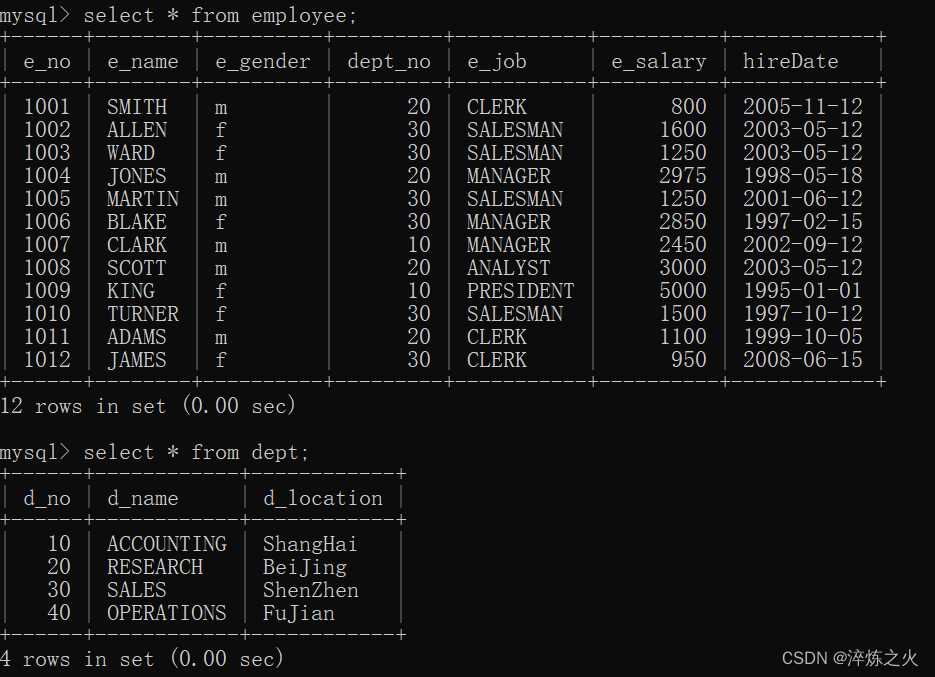
3.
select e_no,e_name,e_salary from employee;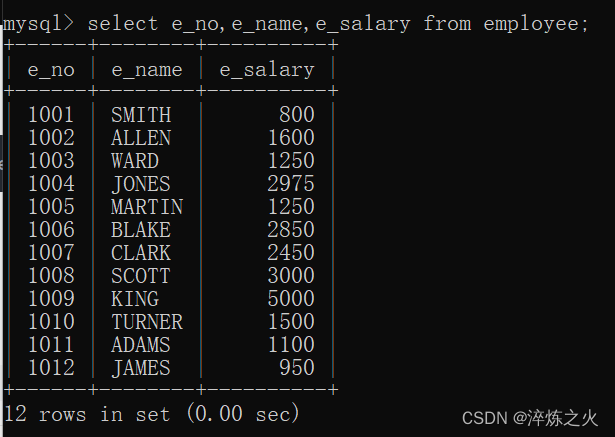
4.
select * from employee where dept_no=10 or dept_no=20; 
5.
select * from employee where e_salary between 800 and 2500; 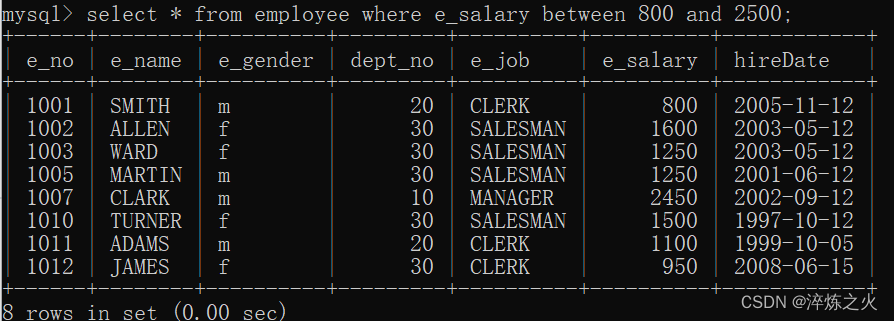
6.
select * from employee where dept_no=20; 
7.
select employee.* from
(select dept_no as dno,max(e_salary)as salary from employee group by dept_no)as a
inner join employee
on employee.dept_no=a.dno and employee.e_salary=a.salary; 
8.
select d_name,d_location from dept where d_no in (select dept_no from employee where e_name='BLAKE'); 
9.
select d_no,d_name,d_location from deptinner join employeeon employee.dept_no=dept.d_no; 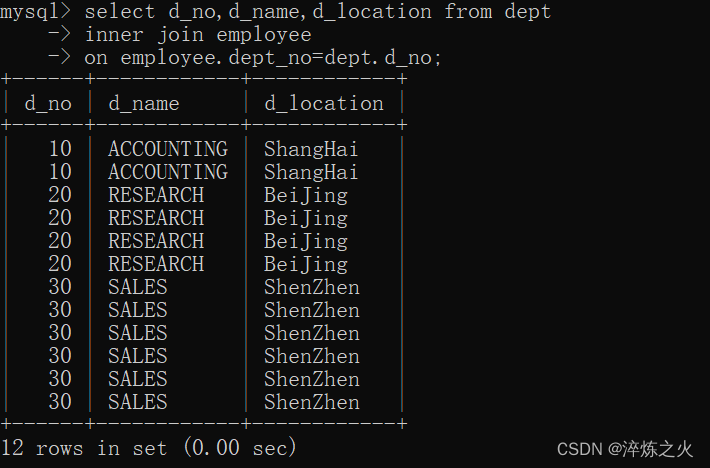
10.
select dept.d_no,count(*)from employee join dept on employee.dept_no=dept.d_nogroup by dept.d_no;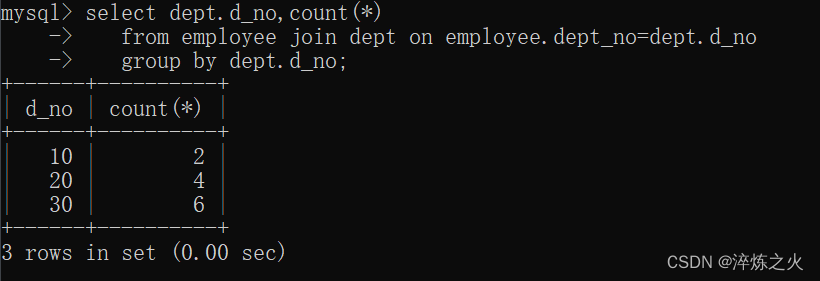
11.
select e_job,sum(e_salary)from employeegroup by e_job; 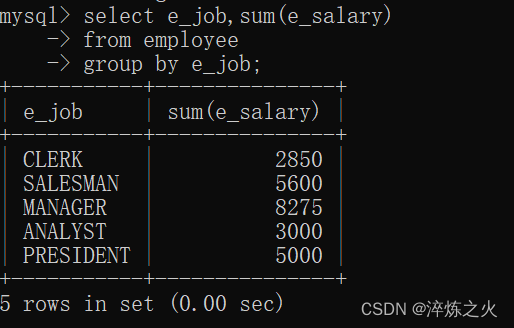
12.
select dept_no,avg(e_salary)from employeegroup by dept_no;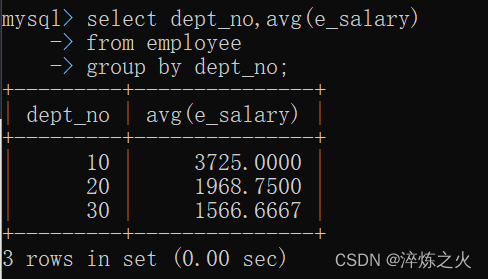
13.
select * from employee where e_salary<1500; 
14.
select * from employee order by dept_no desc;select * from employee order by e_salary desc;
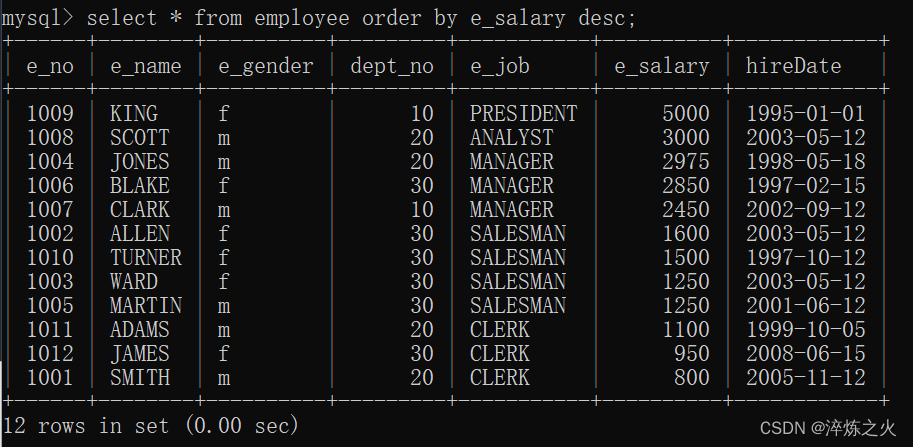
15.
select * from employeewhere e_name like'A%'or e_name like'S%';
16.
select * from employee where hireDate<=(date_sub(curdate(),interval 18 year)); 